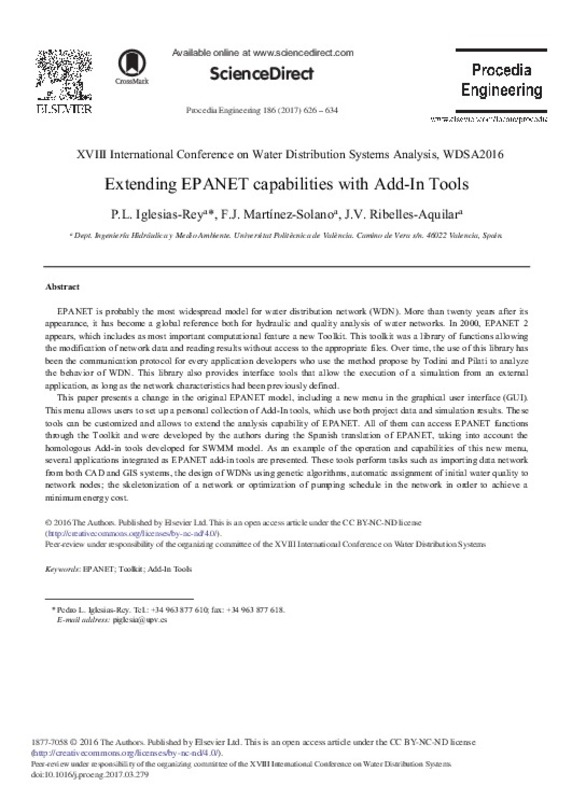JavaScript is disabled for your browser. Some features of this site may not work without it.
Buscar en RiuNet
Listar
Mi cuenta
Estadísticas
Ayuda RiuNet
Admin. UPV
Extending EPANET capabilities with Add-In Tools
Mostrar el registro sencillo del ítem
Ficheros en el ítem
| dc.contributor.author | Iglesias Rey, Pedro Luis
|
es_ES |
| dc.contributor.author | Martínez-Solano, F. Javier
|
es_ES |
| dc.contributor.author | Ribelles-Aguilar, J.V.
|
es_ES |
| dc.date.accessioned | 2018-09-25T07:44:10Z | |
| dc.date.available | 2018-09-25T07:44:10Z | |
| dc.date.issued | 2017 | es_ES |
| dc.identifier.issn | 1877-7058 | es_ES |
| dc.identifier.uri | http://hdl.handle.net/10251/108094 | |
| dc.description.abstract | [EN] EPANET is probably the most widespread model for water distribution network (WDN). More than twenty years after its appearance, it has become a global reference both for hydraulic and quality analysis of water networks. In 2000, EPANET 2 appears, which includes as most important computational feature a new Toolkit. This toolkit was a library of functions allowing the modification of network data and reading results without access to the appropriate files. Over time, the use of this library has been the communication protocol for every application developers who use the method propose by Todini and Pilati to analyze the behavior of WDN. This library also provides interface tools that allow the execution of a simulation from an external application, as long as the network characteristics had been previously defined. This paper presents a change in the original EPANET model, including a new menu in the graphical user interface (GUI). This menu allows users to set up a personal collection of Add-In tools, which use both project data and simulation results. These tools can be customized and allows to extend the analysis capability of EPANET. All of them can access EPANET functions through the Toolkit and were developed by the authors during the Spanish translation of EPANET, taking into account the homologous Add-in tools developed for SWMM model. As an example of the operation and capabilities of this new menu, several applications integrated as EPANET add-in tools are presented. These tools perform tasks such as importing data network from both CAD and GIS systems, the design of WDNs using genetic algorithms, automatic assignment of initial water quality to network nodes; the skeletonization of a network or optimization of pumping schedule in the network in order to achieve a minimum energy cost. | es_ES |
| dc.language | Inglés | es_ES |
| dc.publisher | Elsevier | es_ES |
| dc.relation.ispartof | Procedia Engineering | es_ES |
| dc.rights | Reconocimiento - No comercial - Sin obra derivada (by-nc-nd) | es_ES |
| dc.subject | EPANET | es_ES |
| dc.subject | Toolkit | es_ES |
| dc.subject | Add-In Tools | es_ES |
| dc.subject.classification | MECANICA DE FLUIDOS | es_ES |
| dc.title | Extending EPANET capabilities with Add-In Tools | es_ES |
| dc.type | Artículo | es_ES |
| dc.type | Comunicación en congreso | es_ES |
| dc.identifier.doi | 10.1016/j.proeng.2017.03.279 | es_ES |
| dc.rights.accessRights | Abierto | es_ES |
| dc.contributor.affiliation | Universitat Politècnica de València. Departamento de Ingeniería Hidráulica y Medio Ambiente - Departament d'Enginyeria Hidràulica i Medi Ambient | es_ES |
| dc.description.bibliographicCitation | Iglesias Rey, PL.; Martínez-Solano, FJ.; Ribelles-Aguilar, J. (2017). Extending EPANET capabilities with Add-In Tools. Procedia Engineering. 186:626-634. doi:10.1016/j.proeng.2017.03.279 | es_ES |
| dc.description.accrualMethod | S | es_ES |
| dc.relation.conferencename | 18th International Water Distribution Systems Analysis Conference (WDSA 2016) | es_ES |
| dc.relation.conferencedate | Julio 24-28,2016 | es_ES |
| dc.relation.conferenceplace | Cartagena de Indias, Colombia | es_ES |
| dc.relation.publisherversion | https://doi.org/10.1016/j.proeng.2017.03.279 | es_ES |
| dc.description.upvformatpinicio | 626 | es_ES |
| dc.description.upvformatpfin | 634 | es_ES |
| dc.type.version | info:eu-repo/semantics/publishedVersion | es_ES |
| dc.description.volume | 186 | es_ES |
| dc.relation.pasarela | S\358499 | es_ES |








